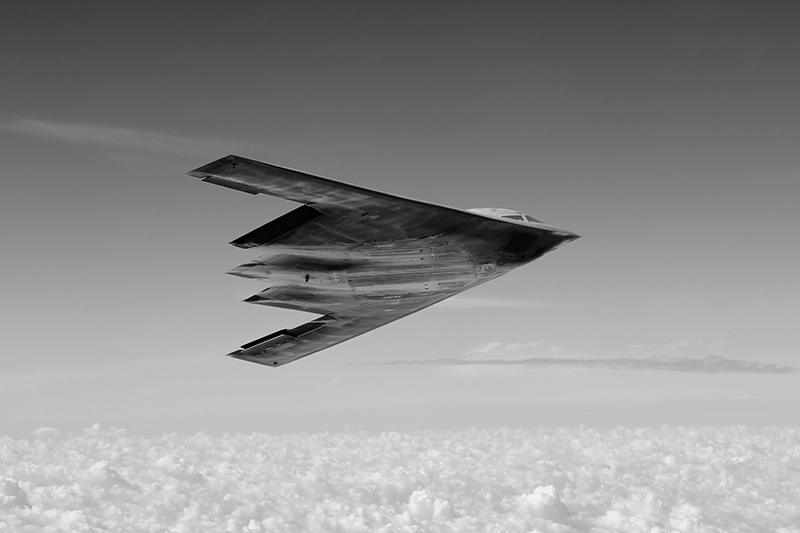DoD
At a Washington Technology-hosted event on March 10th titled “Doing Business with the Air Force,” Air Force Deputy Chief Information Officer Winston Beauchamp highlighted the importance of the Air Force’s Operational Imperatives. This article provides a summary of these imperatives and their significance.
The Defense Department’s 2022 National Defense Strategy (NDS) — which outlines the Department’s strategic direction and priorities for the next four years — identifies Russia and China as primary adversaries to U.S. national security and recognizes the necessity of advancement in U.S. military capabilities in order to deter any potential conflict with these revisionist powers and others like them. In short, the DoD is ramping up its capabilities to prepare for a fight it hopes to deter.
As the arbiters of American air dominance, the U.S. Air Force (USAF) and Space Force (USSF) play a pivotal role in the DoD’s deterrence strategy. A potential conflict with Russia or China would require command and control elements superior to those used in recent conflicts with smaller insurgent groups. In potential conflicts with more advanced militaries, control over air and space is paramount. With this in mind, Secretary of the Air Force Frank Kendall outlined seven Operational Imperatives that serve as a roadmap for forging the future of the USAF and USSF.
- Space Order of Battle
- Operationally-Focused Advanced Battle Management System
- Moving Target Engagement
- Tactical Air Dominance
- Resilient Basing
- Global Strike Capabilities
- Readiness to Deploy and Fight
1. Space Order of Battle
The first operational imperative is to define a resilient and effective space order of battle. More simply stated, this means ensuring resilient space-based capabilities. As Secretary Kendall points out, the U.S. cannot project power successfully unless our space-based services are resilient enough to endure while under attack. Both the cyber and physical security of American satellites and sensors must be maintained to ensure operational capability in a future conflict.
2. Operationally-Focused Advanced Battle Management System
The second operational imperative is to actualize the Advanced Battle Management System (ABMS). ABMS is the Air Force’s contribution to the DoD’s Joint All-Domain Command & Control (JADC2) effort — the DoD’s larger concept to connect sensors from all of the military services into a single network. ABMS will improve how the USAF collects, analyzes, and shares the information needed to make operational decisions at the speed of mission. By incorporating the latest advancements in artificial intelligence, ABMS will revolutionize the speed of battlefield decision-making. With help from private industry partners, the USAF will actualize ABMS in the near future.
3. Moving Target Engagement
The third imperative is to achieve moving target engagement at scale within a challenging operational environment. Linked to ABMS, this operational imperative focuses on the development of sensors that can engage with and destroy targets. This is especially critical for targets that employ the latest technology designed to evade detection, such as hypersonic weapons or stealth capabilities. The development of drone swarms and hypersonic weapons has created a new dimension of warfare that necessitates more advanced targeting systems. In addition, USAF and USSF sensors must be survivable and protected against electromagnetic and cyber operations.
4. Tactical Air Dominance
Fourth, the USAF must define the next generation of air dominance (NGAD) system of systems. Far more than just the development of new 6th-generation fighters, this operational imperative requires the Air Force to integrate crewed aircraft with autonomous aircraft. With NGAD, future crewed aircraft can be accompanied by autonomous wingmen in battle, preserving the lives of pilots without limiting air superiority. This integration will likely define the future of air combat operations.
5. Resilient Basing
Given that threats to USAF operations at forward bases can deny U.S. power projection, the fifth operational imperative is to develop resilient bases and communications. As opposed to the antiquated method of relying on large, fixed bases, the USAF is transitioning to a “hub-and-spoke” arrangement that incorporates smaller, dispersed, and more mobile bases. This concept is also referred to as Agile Combat Employment (ACE). These smaller mobile bases may complicate logistics but will increase survivability in a combat environment. Moreover, this type of base would be particularly advantageous for combat in the Indo-Pacific region.
6. Global Strike Capabilities
The sixth imperative is defining the B-21 long-range strike family-of-systems. Announced in December 2022, the B-21 Raider will serve as the backbone of America’s bomber force. The B-21 Raider is a highly adaptable, dual-capable penetrating strike stealth bomber — capable of delivering both conventional and nuclear munitions. This multi-functional stealth bomber is designed to handle anything from gathering intelligence, to battle management, to integrating with allies and partners. More than just the employment of the B-21, this operational imperative includes the use of autonomous combat aircraft and other long-range strike aircraft alongside the B-21.
7. Readiness to Deploy and Fight
Finally, the seventh operational imperative is achieving readiness for a wartime posture against a peer competitor. According to Secretary Kendall, shifting “from a standstill to mobilizing forces, moving them into theater, and then supporting them takes the collective success of a large number of information systems and supporting logistical and industrial infrastructure.” Ensuring the readiness will require effort from the entire USAF and USSF but is instrumental in persuading potential enemies to choose the path of peace.
Implications for Industry
As Chief of Staff of the Air Force, Gen. Charles Q. Brown, Jr., points out, the Air Force must accelerate, change, or lose. Complacency is simply not an option for the DoD and its branches. With the operational imperatives in place, the USAF and USSF are well-positioned to achieve their desired modernization at an accelerated pace. Yet, this advancement is only made possible by a close partnership with private industry. To ensure victory in potential battles to come, the USAF must continue to leverage our greatest resource, American ingenuity and innovation. To learn more about partnership opportunities, visit GovTribe. For more information on the aerospace industry, visit Forecast International and Military Periscope.
Written by David Hutchins, Industry Analyst (Government Business Council). To see more thought leadership from David, connect with him on LinkedIn.
by David Hutchins – Industry Analyst (Government Business Council)
The Department of Defense (DoD) is consistently adapting to compete with and deter potential adversaries as advancements in technology continue to change the nature of warfare. As the capabilities of potential adversaries become more sophisticated and the U.S. military seeks to maintain its technological advantage on the battlefield, the ability to quickly correlate, evaluate, and disseminate data becomes increasingly critical. Leveraging the Internet of Things (IoT) is one key to the future success of the U.S. armed forces.
What is the Internet of Things?
The Internet of Things is a network of physical objects, or things, embedded with software, sensors, or other technologies for the purpose of connecting and exchanging data with other devices and systems over the internet. IoT devices range from ordinary household objects to sophisticated industrial tools. Within the realm of the U.S. military, IoT connects satellites, radar, smartphones, wearable devices, munitions, drones, aircraft, ground vehicles, naval ships, weapon systems, and much more into a cohesive network. The armed forces can use legions of these devices to continuously collect, process, and share data.
IoT Implications for Future Warfare
The complexities of contemporary warfare are pushing militaries toward a more integrated warfare approach that leverages data and connectivity. IoT provides the abundance of data and connectivity needed to gain an advantage on the battlefield. A cohesive network of IoT devices improves situational awareness, risk assessment, and response time. For example, the U.S. military transmits data collected by IoT through C4ISR systems that process and disseminate the most mission-critical information, such as incoming threats, patterns in enemy behavior, and supply chain anomalies. IoT has numerous other applications including gathering battlefield data, monitoring troop health, and managing fleet logistics. This military application of IoT is also referred to as the Internet of Battlefield Things (IoBT) or the Internet of Military things (IoMT).
Ultimately, IoT gives a more complete picture of the battlefield and provides decision-makers with sufficient data at the speed of mission, enabling real-time, informed battlefield intelligence. IoT can also be integrated with edge computing and artificial intelligence (AI) or machine learning (ML) to interpret and optimize battlespace operations in milliseconds. This capability is critical to actualizing Joint All Domain Command and Control (JADC2) — the DoD’s concept to connect sensors from all of the military services (Air Force, Army, Marines, Navy, and Space Force) into a single network of combined intelligence, surveillance, and reconnaissance (ISR) data. The U.S. military is even using IoT to gather, process, and transmit data in contested and remote environments by leveraging technological advancements such as 5G and long-range wide-area networks (LoRaWAN).
IoT Spotlight
The Armaments Research Company (ARC), in partnership with Sig Sauer, is using IoT technology to provide soldiers with real-time data on the condition and readiness of rifles selected for the Army’s Next Generation Squad Weapons (NGSW) program — an effort the Army launched in 2017 to prototype and develop more lethal small arms for the close combat force. ARC’s platform will reportedly use an IoT system to monitor individual weapons at scale. According to ARC, the resulting insights will enable units to regularly assess weapons’ condition, reduce failure rates, extend the weapon lifetime, and optimize maintenance plans. This will ultimately enhance performance, reduce costs, and improve combat readiness.
Another example of IoT-enabled warfighting is the Command, Control, Battle Management, and Communications System (C2BMC). Using 48,000 miles of classified communication network lines, C2BMC merges data from hundreds of sensors, radars, and satellites, connecting different elements of the U.S. military’s Ballistic Missile Defense System (BMDS) into one central hub which can be used to counteract threats all over the world. By leveraging IoT, C2BMC is a force multiplier for global military operations.
Challenges on the Horizon
Familiar to all in the defense industry is the importance of cybersecurity. The unfortunate reality of IoT is that broad, interconnected networks have a larger attack surface for malicious actors to target. If compromised, inadequately secured networks could provide enemies with strategic information such as troop movements and logistics. Unlike commercial network infrastructures, the military’s IoT must be ready to operate in hostile or unstable environments which can require a high degree of intelligence to navigate. To mitigate cyber threats, the DoD must work with industry allies to protect its networks by layering multiple cyber defense techniques — such as adding detection systems, training personnel, and collecting data on adversaries.
By David Hutchins, Industry Analyst
On October 27, 2022, the Department of Defense (DoD) publicly released the latest National Defense Strategy (NDS). Released every four years, the NDS is subsequent to the President’s National Security Strategy and sets the DoD’s strategic direction and priorities for the next four years. The NDS serves as an important declaration of focus that both US allies and adversaries will closely examine. With an ongoing war in Ukraine, the threat of a new nuclear-armed adversary in the Middle East, and a rising adversary in the Indo-Pacific, Secretary of Defense Lloyd J. Austin III rightly refers to this decade as “turbulent times.” This article unpacks the implications the NDS will have on the defense industry and what this industry can expect in the next four years.
The 2022 NDS lists four top-level defense priorities that the DoD must pursue in order to strengthen deterrence:
- Defending the homeland.
- Deterring strategic attacks against the United States, Allies, and partners.
- Deterring aggression, while being prepared to prevail in conflict when necessary — prioritizing the PRC challenge in the Indo-Pacific region, then the Russia challenge in Europe.
- Building a resilient Joint Force and defense ecosystem.
In addition, the NDS lists three approaches to carrying out the priorities listed above:
- Integrated Deterrence
- Campaigning
- Building Enduring Advantages
Geopolitical Implications:
The previous National Defense Strategy already identified China and Russia as primary adversaries to US National Security, and the 2022 NDS reaffirms that strategic competition with these countries is a top priority. China in particular is viewed as the greatest threat to global order, even as Russia is actively engaged in a war with Ukraine. This means that any entity with an active or planned partnership with either China or Russia will face increased scrutiny in the coming years. Any involvement from Chinese or Russian companies in supply chains may become increasingly difficult or outright illegal. The Countering America’s Adversaries Through Sanctions Act (CAATSA) already penalizes entities for buying or selling military equipment with Russia. If China were to invade Taiwan, these same measures could be extended to any cooperation with China. Moreover, the defense industries of allied countries that choose to partner with Russia or China may find the US to be less tolerant of these actions.
Increased cooperation with existing allies and the formation of a resilient defense ecosystem are also common themes throughout the NDS. The NDS places emphasis on working closely with NATO allies and allies in the Indo-Pacific region, specifically Japan, South Korea, India, Australia, and Taiwan. It’s likely that multi-national production efforts, like the Joint Strike Fighter program, will become more commonplace as the US looks to solidify strategic partnerships while strengthening defense capabilities.
The 2022 NDS also references a need for increased activity in the Arctic region. Warming temperatures have created new corridors of strategic interaction through the arctic that have both created new opportunities and increased competition in the area. For companies with supply lines through the arctic, developments in this region should be closely monitored. In addition, the arctic represents a potential new battleground that would require military equipment and tools that are specially tailored to operate in the extreme cold.
New Arms Race for Emerging Technologies
Of the three approaches outlined in the NDS, the most pertinent to the defense industry is Building Enduring Advantages. This approach can be viewed as somewhat of a new arms race with a focus on emerging technologies that could prove decisively advantageous in a future conflict. The United States and its allies are competing with potential adversaries, such as Russia and China, to develop and refine the latest military technologies and the software that supports them. The NDS points out that these technologies are front of mind for the DoD, stating that the department will “modernize the systems that design and build the Joint Force, with a focus on innovation and rapid adjustment to new strategic demands.” The DoD plans to build enduring advantages by leveraging a “culture of ingenuity” across the defense industrial base, including the many private sector and academic enterprises that work to modernize the Joint Force.
The DoD will seek to acquire technologies that help achieve its five future force priorities — lethality, sustainability, resiliency, survivability, and agility & responsiveness. More specifically, the defense industry can expect increased, or at least continued, investment from the DoD in technologies such as counter-space weapons, directed energy, hypersonics, integrated sensing, drone/UAV technology, robotics, autonomous systems, artificial intelligence, microelectronics, biotechnology, quantum science, and clean energy. The enduring partnership between the DoD, the private sector, and research institutions is vital to developing the latest innovations and ensuring that the United States does not fall behind its adversaries and diminish its technological edge.
Climate Change & Clean Energy
In recent years, the DoD has recognized climate change as a considerable threat that increasingly strains the Joint Force. With this in mind, the NDS places greater emphasis on reducing energy demand, developing clean energy technologies, and building a Joint Force that’s more resilient to climate change.
The concept of a fuel-efficient military using renewable energy sources may have seemed preposterous in past years, yet the concern around climate change has made it a very appealing aspiration. Acknowledging that national security, the defense industry, and the energy industry are all tightly interwoven, the DoD is seeking help from private industry to make advancements in clean energy technology and develop systems that can operate using them. As stated in the NDS, the DoD will “make reducing energy demand a priority, and seek to adopt more efficient and clean-energy technologies that reduce logistics requirements in contested or austere environments.”
The DoD is also partnering with private industry to strengthen the Department’s ability to withstand and recover quickly from climate events. From infrastructure on forward operating bases to the weapons that protect them, all aspects of military operations will need to consider climate resilience as part of the defense ecosystem. According to the NDS, the DoD will integrate climate change into threat assessments, increase the climate resilience of military installations, analyze climate change impacts on the Joint Force, and take climate extremes into account in decisions related to training and equipping the force.
Conclusive Thoughts
The NDS illustrates that US national security faces no shortage of threats. Regardless of whether the next challenge is brought by China, Russia, or a more transboundary threat like a pandemic or climate change, what’s most essential is ensuring that the Department of Defense has the tools needed to respond to those threats. The DoD has long relied on its partnership with the defense industry to develop the innovations that maintain our technological advantage on the battlefield. Although the battlefield may be changing, this concept has not changed. The DoD will continue to count on innovations from private industry to prepare our warfighters for whatever comes next.
By Jonathan Sanders, Director, Research, GovExec
In FY 2022, nearly $18.4 billion of the U.S. Navy’s prime contract awards went to small businesses— $1.4 billion (8.2%) increase from $17 billion last year.
Over the last five years, the Navy has typically spent the following amounts with small businesses:
- Engineering Services – $4 billion
- Commercial and Institutional Building Construction – $3 billion
- Ship Building & Repairing – $3 billion
- Deep Sea Freight Transportation – $2 billion
- Research and Development in the Physical, Engineering, and Life Sciences (except Nanotechnology & Biotechnology) – $2 billion
- Other Computer Related Services – $1 billion
- Computer Systems Design Services – $926 million
- Facilities Support Services – $690 million
- Administrative Management and General Management Consulting Services – $675 million
- Aircraft Manufacturing – $652million
More opportunities in FY2023
In FY2023, the Navy plans to create even more opportunities for small businesses by breaking up five major contracts into smaller awards, thus providing small businesses opportunities to compete for contract work. The Navy has not yet said which contracts will be included.
However, Jimmy Smith, Director of the Office of Small Business Programs at the Department of the Navy said: “… we know all the contracts that are sun-setting on the horizon. If they fall into the right time frame, we’re breaking them up into many parts to create opportunities for small businesses to increase our small business participation.” (source)
A search in GovTribe highlights awards in the top 10 NAICSs that are ending in the next 12 months and are not small business set asides:
- Submarines (Electric Boat Corporation)
- Aircraft Fixed Wing (Lockheed Martin Corporation)
- Combat Ships and Landing Vessels (Lockheed Martin Corporation)
- Combat Ships and Landing Vessels (Huntington Ingalls Corporation)
- Combat Ships and Landing Vessels (Huntington Ingalls Corporation)
- Destroyers (Bath Iron Works Corporation)
- Combat Ships and Landing Vessels (Lockheed Martin Corporation)
- Aircraft, Fixed Wing (Lockheed Martin Corporation)
- Aircraft, Rotary Wing (Bell Textron Incorporated)
- Aircraft, Fixed Wing (Lockheed Martin Corporation)
What this means for you
There is opportunity for small businesses in the Navy in the coming months. Now is the time to prepare your small business to win these contracts.
Insights, Research, and YOUR Path to More Awards
GovExec’s Insights & Research Group (comprising Market Connections, Government Business Council, and Leading Brands) and GovTribe can keep you up to date on what is happening in this rapidly changing contract environment.
GovTribe is a collaborative platform that lends business development teams a hand through research and tracking of contracting vehicles as well as targeted intelligence on GSA Federal Supply Schedules, GWACS, IDIQs, and other multiple award vehicles.
Combining the data, insights, and expert analysis you get at Market Connections with the ease, agility, and usability of GovTribe can help you strategically position yourself right where you want to be for future opportunities.
Questions? Please reach out to Jonathan Sanders at jsanders@govexec.com.








